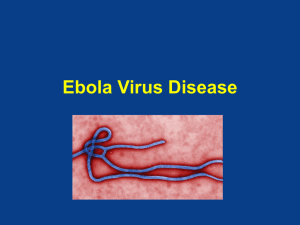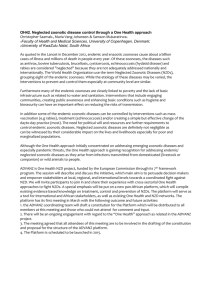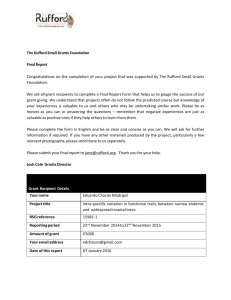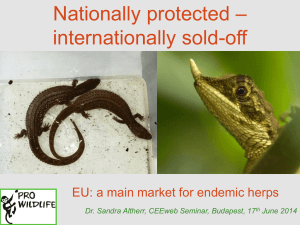Hyrcanian Montagne Forest
advertisement
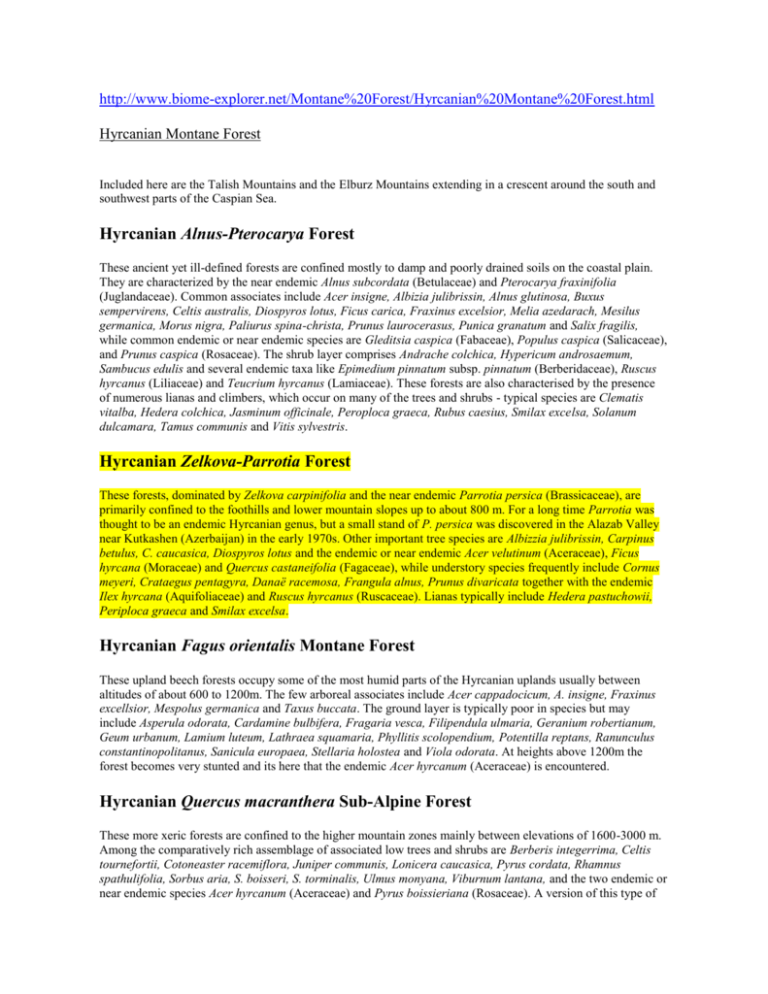
http://www.biome-explorer.net/Montane%20Forest/Hyrcanian%20Montane%20Forest.html Hyrcanian Montane Forest Included here are the Talish Mountains and the Elburz Mountains extending in a crescent around the south and southwest parts of the Caspian Sea. Hyrcanian Alnus-Pterocarya Forest These ancient yet ill-defined forests are confined mostly to damp and poorly drained soils on the coastal plain. They are characterized by the near endemic Alnus subcordata (Betulaceae) and Pterocarya fraxinifolia (Juglandaceae). Common associates include Acer insigne, Albizia julibrissin, Alnus glutinosa, Buxus sempervirens, Celtis australis, Diospyros lotus, Ficus carica, Fraxinus excelsior, Melia azedarach, Mesilus germanica, Morus nigra, Paliurus spina-christa, Prunus laurocerasus, Punica granatum and Salix fragilis, while common endemic or near endemic species are Gleditsia caspica (Fabaceae), Populus caspica (Salicaceae), and Prunus caspica (Rosaceae). The shrub layer comprises Andrache colchica, Hypericum androsaemum, Sambucus edulis and several endemic taxa like Epimedium pinnatum subsp. pinnatum (Berberidaceae), Ruscus hyrcanus (Liliaceae) and Teucrium hyrcanus (Lamiaceae). These forests are also characterised by the presence of numerous lianas and climbers, which occur on many of the trees and shrubs - typical species are Clematis vitalba, Hedera colchica, Jasminum officinale, Peroploca graeca, Rubus caesius, Smilax excelsa, Solanum dulcamara, Tamus communis and Vitis sylvestris. Hyrcanian Zelkova-Parrotia Forest These forests, dominated by Zelkova carpinifolia and the near endemic Parrotia persica (Brassicaceae), are primarily confined to the foothills and lower mountain slopes up to about 800 m. For a long time Parrotia was thought to be an endemic Hyrcanian genus, but a small stand of P. persica was discovered in the Alazab Valley near Kutkashen (Azerbaijan) in the early 1970s. Other important tree species are Albizzia julibrissin, Carpinus betulus, C. caucasica, Diospyros lotus and the endemic or near endemic Acer velutinum (Aceraceae), Ficus hyrcana (Moraceae) and Quercus castaneifolia (Fagaceae), while understory species frequently include Cornus meyeri, Crataegus pentagyra, Danaë racemosa, Frangula alnus, Prunus divaricata together with the endemic Ilex hyrcana (Aquifoliaceae) and Ruscus hyrcanus (Ruscaceae). Lianas typically include Hedera pastuchowii, Periploca graeca and Smilax excelsa. Hyrcanian Fagus orientalis Montane Forest These upland beech forests occupy some of the most humid parts of the Hyrcanian uplands usually between altitudes of about 600 to 1200m. The few arboreal associates include Acer cappadocicum, A. insigne, Fraxinus excellsior, Mespolus germanica and Taxus buccata. The ground layer is typically poor in species but may include Asperula odorata, Cardamine bulbifera, Fragaria vesca, Filipendula ulmaria, Geranium robertianum, Geum urbanum, Lamium luteum, Lathraea squamaria, Phyllitis scolopendium, Potentilla reptans, Ranunculus constantinopolitanus, Sanicula europaea, Stellaria holostea and Viola odorata. At heights above 1200m the forest becomes very stunted and its here that the endemic Acer hyrcanum (Aceraceae) is encountered. Hyrcanian Quercus macranthera Sub-Alpine Forest These more xeric forests are confined to the higher mountain zones mainly between elevations of 1600-3000 m. Among the comparatively rich assemblage of associated low trees and shrubs are Berberis integerrima, Celtis tournefortii, Cotoneaster racemiflora, Juniper communis, Lonicera caucasica, Pyrus cordata, Rhamnus spathulifolia, Sorbus aria, S. boisseri, S. torminalis, Ulmus monyana, Viburnum lantana, and the two endemic or near endemic species Acer hyrcanum (Aceraceae) and Pyrus boissieriana (Rosaceae). A version of this type of forest occurs in the high altitude, rocky forest of Dodangeh south of Sari. This is the last refuge of the endemic tree Betula pendula (Betulaceae). Studies show that this species and Corylus avellana are relicts of an ancient more extensive Hyrcanian forest that has now largely disappeared. Species found associated with these Betula stands include a rich variety of endemic taxa such as Alchemilla farinosa (Asteraceae), Cortusa matthiola subsp. iranica (Primulaceae), Delphinium elbursense var. elbursense (Ranunculaceae), Scabiosa hyrcanica (Dipsaceae), Semervivum iranicum (Crassulaceae) and Stachys persica (Lamiaceae). Hyrcanian Cupressus sempervirens Forest These rare cypress forests are thought to be relict stands of a once much more extensive forest of ancient Mediterranean vegetation that probably pre-dates much of the current Hyrcanian vegetation. References Browicz, K. 1987. Chorology of the Euxinian and Hyrcanian elements in the woody flora of Asia. Plant Systematics and Evolution, 162: 305-314. Ejtehadi, H., Zare, H., Akbarinia, M. & Hosseini, M. 2004. Ecological study of Betula pendula stands in Hyrcanian forests, Northern Iran. Acta Botanica Hungarica, 46: 143-151. Frey, W. & Probst, W. 1986. A synopsis of the vegetation of Iran. In: Contributions to the Vegetation of Southwest Asia. Ed. H. Kürschner. Dr. Ludwig Reichert Verlag. Hedge, C. & Wendelbo, P. 1978. Patterns of distribution and endemism in Iran. Notes of the Royal Botanic Garden, Edinburgh, 36: 441-464. Heshmati, G. A. 2007. Vegetation characteristics of four ecological zones of Iran. Journal of Plant Production, 1: 215-224. Zohary, M. 1971. The Phytogeographical Foundations of the Middle East. In: Plant Life of South-West Asia. Eds. P. H. Davies, P. C. Harper & I. C. Hedge. The Botanical Society of Edinburgh. Zohary, M. 1973. Geobotanical Foundations of the Middle East. Volumes 1 & 2. Gustav Fischer Verlag, Stuttgart & Swets & Zeitlinger, Amsterdam. Zohary, M., Heyn, C. C. & Heller, D. 1980. Conspectus Florae Orientalis. The Israel Academy of Science and Humanities. Jerusalem. Hyrcanian Endemic Plants Endemics in Family Order Amaryllidaceae Allium lenkoranicum Aquifoliaceae Ilex hyreana Apiaceae Chaerophyllum meyeri Asparagaceae Ornithogalum bungei Ruscus hyrcanus Asteraceae Amblyocarpum inuloides Cousinia hablizii Doronicum wendelboii Berberidaceae Epimedium pinnatum Betulaceae Alnus cordifolia var. subcordata Boraginaceae Caccinia strigosa Eritrichium gracillimum Lepechiniella persica Lepechiniella wendelboi Lindelofia kandavanensis Myosotis anomala Nonea longiflora Onosma anisocalyx Onosma borragoidina Onosma sharifi Onosma urmensis Paracaryum pygmaeum Rindera regia Rochelia mirheydari Brassicaceae Elburzia fenestrata Thlaspi inhumile Buxaceae Buxus hyrcana Caprifoliaceae Pterocephalus glandulissimus Scabiosa hyrcanica Caryophyllaceae Saponaria bodeana Crassulaceae Sempervivum iranicum Fabaceae Gleditsia caspica Fagaceae Quercus aegilops var. castaneifolia Geraniaceae Geranium montanum Hamamelidaceae Parrotia persica Iridaceae Crocus boryanus var. caspius Crocus hyrcanus Lamiaceae Ballota platyloma Betonica nivea subsp. mazandarana Lophanthus allotrius Origanum hyrcanum Phlomis ghilanensis Salvia hypoleuca Scutellaria glechomoides Scutellaria tournefortii Stachys laxa Stachys persica Stachys subaphylla Stachys talyschensis Teucrium hyrcanum Liliaceae Fritillaria canum Fritillaria grandiflora Lilium ledebourii Linaceae Linum bungei Malvaceae Alcea gorganica Alcea hyrcana Alcea sotudehi Malvalthaea heterphylla Malvalthaea palmata Moraceae Ficus ovata var. octomelifolia Onagraceae Epilobium rechingeri Orobanchaceae Orobanche eriophora Pedicularis rechingeri Rhynchocorys maxima Papaveraceae Corydalis chionophila subsp. firouzii Corydalis persica var. hyrcana Papaver chelidoniifolium Phyllanthaceae Andrachne pulvinata Plantaginaceae Linaria demawendica Veronica aucheri Veronica bungei Veronica chionantha Veronica euphrasiifolia Veronica francispetae Veronica mazanderanae Veronica mirabilis Veronica paederotae Veronica rechingeri Plumbaginaceae Acantholimon bodeanum var. faustii Acantholimon demavendicum Acantholimon embergeri Acantholimon esfandiarii Acantholimon gadukense Acantholimon ophiocladus Acantholimon scirpinum Acantholimon scorpius Acantholimon senganense Acantholimon serotinum Acantholimon sorchense Acantholimon spinicalyx Polygalaceae Polygala platyptera Primulaceae Cortusa matthioli subsp. iranica Cyclamen coum subsp. elegans Dionysia aretioides Primula heterochroma Ranunculaceae Aconitum iranshahrii Delphinium elbursense Ranunculus dolosus Rosaceae Alchemilla amardica Alchemilla condensa Alchemilla farinosa Alchemilla melancholica Potentilla gilanica Potentilla kandauensis Potentilla radiata Potentilla sischanensis var. peterae Prunus divaricata Pyrus boissieriana Pyrus grossheimii Pyrus hyrcana Pyrus mazanderanica Rosa rechingeri Rubus persica Rubus rechingeri Rubiaceae Asperula mazanderanica Asperula microphylla Galium aucheri Galium elbursense Galium subvelutinum subsp. delicatulum Matthiola subglabra Salicaceae Populus caspica Sapindaceae Acer hyrcanum Acer monspessulanum Acer velutinum Saxifragaceae Saxifraga mazanderanica Scrophulariaceae Scrophularia crassicaulis Scrophularia elbursensis Scrophularia gaubae Scrophularia gorganica Scrophularia hyrcana Scrophularia megalantha Scrophularia rostrata Verbascum stachydiforme Verbascum sublobatum Solanaceae Atropa pallidiflora Solanum kieseritzkii Thymelaeaceae Daphne rechingeri Violaceae Viola spathulata Summary Included here are relict Hyrcanian forests of the coastal plains extending in a crescent around the south and southwest of the Caspian Sea including the area around Lenkoran, Gilan and Mazanderan. It also extends up the northwestern slopes of the Talish Mountains and the northern slopes of the Elburz Mountains. Of the endemic and near endemic vascular plants so far recorded there are 138 species in 83 genera and 41 families but no endemic genera. However, this area is a refuge for the near endemic genus Parrotia which is a surviving member of the once widely distributed family Hamamelidaceae. References Browicz, K. 1987. Chorology of the Euxinian and Hyrcanian elements in the woody flora of Asia. Plant Systematics and Evolution, 162: 305-314. Hedge, C. & Wendelbo, P. 1978. Patterns of distribution and endemism in Iran. Notes of the Royal Botanic Garden, Edinburgh, 36: 441-464. Zohary, M. 1971. The Phytogeographical Foundations of the Middle East. In: Plant Life of South-West Asia. Eds. P. H. Davies, P. C. Harper & I. C. Hedge. The Botanical Society of Edinburgh. Zohary, M. 1973. Geobotanical Foundations of the Middle East. Volumes 1 & 2. Gustav Fischer Verlag, Stuttgart & Swets & Zeitlinger, Amsterdam. Zohary, M., Heyn, C. C. & Heller, D. 1980. Conspectus Florae Orientalis. The Israel Academy of Science and Humanities. Jerusalem.

